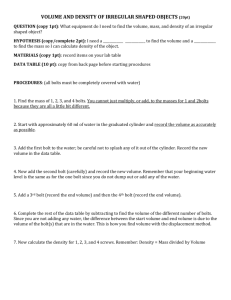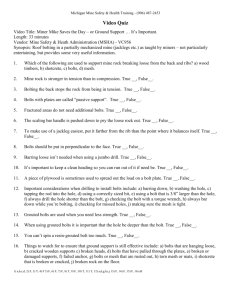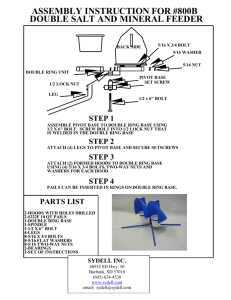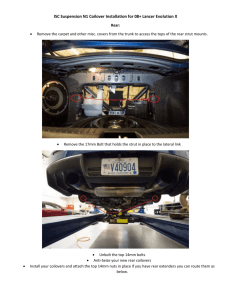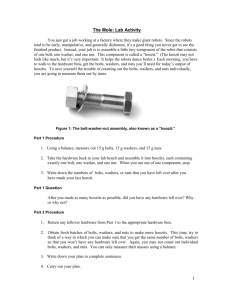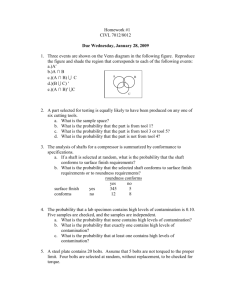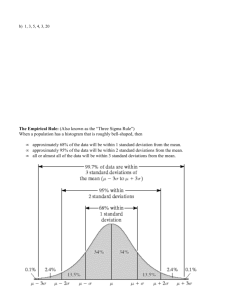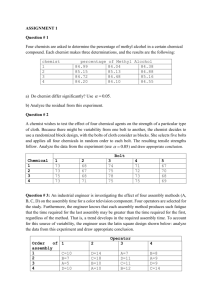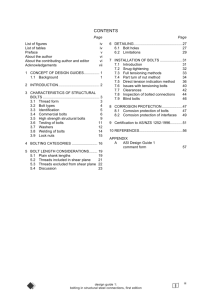Bolting: Attachment Of The Mudsill To The
advertisement
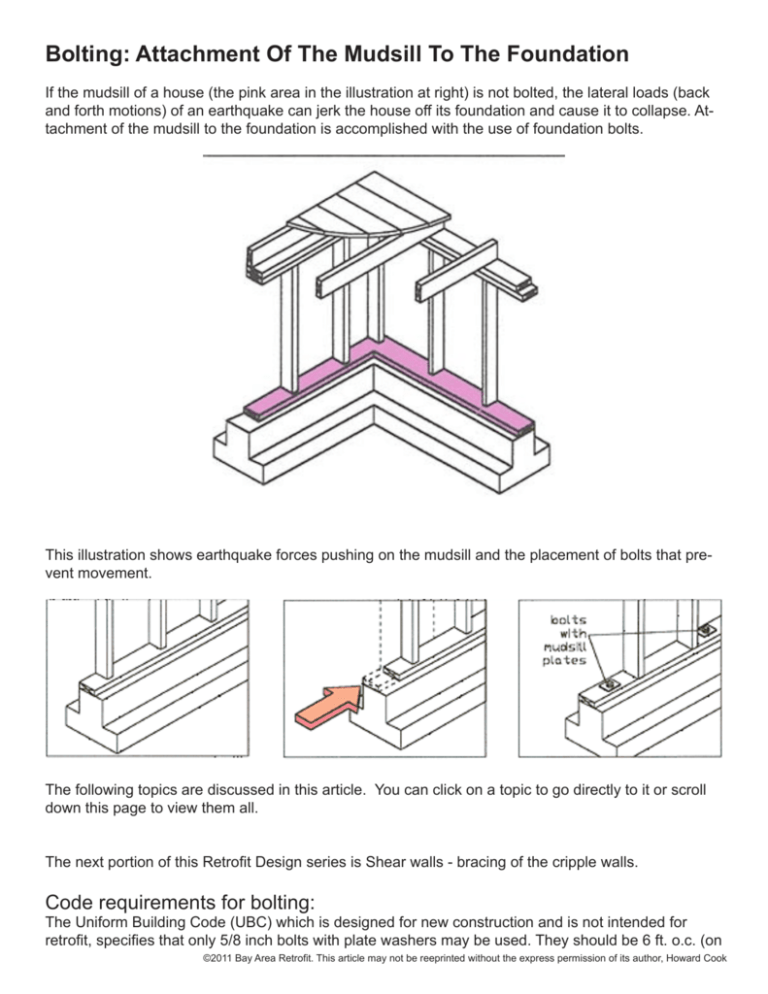
Bolting: Attachment Of The Mudsill To The Foundation If the mudsill of a house (the pink area in the illustration at right) is not bolted, the lateral loads (back and forth motions) of an earthquake can jerk the house off its foundation and cause it to collapse. Attachment of the mudsill to the foundation is accomplished with the use of foundation bolts. This illustration shows earthquake forces pushing on the mudsill and the placement of bolts that prevent movement. The following topics are discussed in this article. You can click on a topic to go directly to it or scroll down this page to view them all. The next portion of this Retrofit Design series is Shear walls - bracing of the cripple walls. Code requirements for bolting: The Uniform Building Code (UBC) which is designed for new construction and is not intended for retrofit, specifies that only 5/8 inch bolts with plate washers may be used. They should be 6 ft. o.c. (on ©2011 Bay Area Retrofit. This article may not be reeprinted without the express permission of its author, Howard Cook center) on single and two story homes. Three story homes require an engineer. Older building codes, 1994 and earlier, required 1/2 inch bolts spaced 6 ft. apart no matter how many stories. The Uniform Code of Building Conservation (UCBC), which is a retrofit code applicable to existing homes, requires 1/2 inch a bolts with plate washers be installed 6 ft. o.c. on one story buildings, 1/2 inch bolts with plate washers installed 4 ft. o.c. on two story buildings, and 5/8 inch bolts with plate washers installed 4 ft. o.c. on three story buildings. The importance of plate washers will be discussed in this article. Types of bolts: The most common foundation bolts are either mechanical wedge anchors or epoxy bolts, 1/2 inch or 5/8 inch in diameter. The mechanical wedge anchor is installed by drilling a hole through the mudsill into the concrete, beating the wedge anchor into the hole with a sledge hammer and then tightening the bolt. A “wedge” on the bottom of the bolt expands while it is being tightened which secures the bolt into the concrete. An epoxy bolt is installed in the same manner except that it is glued into the hole with epoxy. All seismic retrofit codes i.e., The International Conference of Building Officials (ICBO), The Uniform Code of Building Conservation (UCBC), and the Los Angeles Retrofit Code recognize no difference in earthquake resistance between wedge anchors and epoxy bolts as long as they are installed per manufacturer’s installation instructions. Generally speaking, epoxy bolts are installed when the concrete is in poor condition or the bolts are being installed in brick. They are also the most common type of bolt installed in the San Francisco Bay Area, while mechanical wedge anchors are the most common type of bolt installed in Southern California. This difference merely reflects a “common construction practice” for these geographic areas. However epoxy bolts are always used when anticipated forces will be trying to pull the bolt upward out of the concrete, such as in the installation of holddowns. Rusting of bolts: A common problem that occurs in areas with high moisture involves rusting of the bolts, regardless of which type is used. If a bolt is rusted to the point that the nut is corroded fast to the bolt and cannot be removed, the bolt should be replaced. When trying to remove the nuts and replace the washers, we have snapped off many rusted bolts. Even though the bolts look sound, they can be rusted away where the bolt and the concrete meet. We have seen bolts where less than 1/8 of an inch of the original bolt was left even though the nut and bolt looked intact. We recommend bolts showing severe rust be replaced with hot-dipped galvanized wedge anchors or epoxy bolts. Recessed bolts: Another problem is bolts that are recessed into the mudsill. This occurs because the bolts were not sticking up far enough when the foundation was poured. When the contractor installs his dimensional 2-by mudsill on a foundation that has bolts sticking up only 1-1/2 inches, he has to chisel out the mudsill around the bolts in order to get the nuts on. In this situation it is rarely possible to adequately tighten the nuts and it is impossible to install plate washers and mudsill plates. Recessed bolts should be considered marginally functional and should be replaced. ©2011 Bay Area Retrofit. This article may not be reeprinted without the express permission of its author, Howard Cook Bolt penetration: A primary area of concern when examining the bolting of a building to the foundation is the amount of penetration into the concrete. While the UBC requires a 7 inch embedment into the concrete in new construction, the manufacturers of wedge anchors and other mechanical anchors require much less penetration. Manufacturers of 1/2 inch wedge anchors such as Hilti, Ramset/Red Head, Dualbolt, Rawl, etc. generally only require 3-1/2 inches embedment into the concrete for “minimum embedment” and 5-3/4 inches of embedment into the concrete for “standard embedment” into 2000 Psi concrete. 5/8 inch bolts usually require 4 inch minimum embedment and 6-1/4 inches standard embedment. Ratings in shear strength are higher for standard embedments. For example, according to I.C.B.O. Evaluation Report 1372 dated February 1, 1997, a 1/2 inch bolt with minimum embedment can withstand 1190 pounds of force in shear while the same bolt with standard embedment can withstand 1810 pounds of force in shear. However, it must be remembered that for a 1/2 inch bolt, the building code allows a 2-by mudsill only 840 pounds in shear resistance irrespective of the bolt embedment. What this means in terms of the strength of the connection of the mudsill to the concrete is that it does not matter if the bolt is embedded 2 inches or 20 inches. The failure will occur when the piece of wood that forms the mudsill splits at 840 pounds of force no matter how deep the bolt extends into the concrete. Note photo at right. Plate washers: A major area of concern in accessing strength of a bolt is the type of washer used to connect it to the mudsill. As an earthquake tries to jerk the mudsill off the foundation, the foundation bolts do not snap off, rather the mudsill splits in two with the bolts acting somewhat like the head of an ax. See the photo at right. The failure occurs in this manner because the connection of the bolt to the concrete foundation is much stronger than the connection of the bolt to the soft wooden mudsill. For this reason modern retrofit codes do all they can to strengthen the connection of the bolt to the mudsill by using special washers and by increasing the thickness of the lumber that forms the mudsill. After the Northridge earthquake, a tremendous amount of research was done to strengthen the bolt-to-mudsill connection since so many failures occurred at this location. ©2011 Bay Area Retrofit. This article may not be reeprinted without the express permission of its author, Howard Cook The most significant increase in strength in this connection was achieved by installing large square plate washers on the bolts instead of round cut washers. See the photo at left. This one simple change resulted in a 60% increase in strength. That is why the 1997 Uniform Building Code and the Uniform Code of Building Conservation require these washers on all foundation bolts. These plate washers, known as bearing plates in the Simpson catalog, are also commonly referred to as compression washers. The graph below demonstrates the advantages of using plate washers over roundcut washers. The Y axis of this detail represents force applied to a mudsill measured in pounds. The X axis represents the amount of movement (deflection) of the mudsill in inches. The lower line measures deflection with a standard round-cut washer. The upper line measures deflection with a plate washer. Oversized bolt holes: The Uniform Building Code requires that a foundation bolt be installed in a hole whose diameter is no more than 1/16 of an inch larger than the diameter of the bolt. These compression washers go a long way in compensating for holes that are more than 1/16 of an inch larger. The most recent version of the Los Angeles retrofit code actually requires that oversized bolt holes be filled with epoxy. Needless to say, for any type of washer to work, the nuts must be tight. The problem with oversized bolt holes can been readily seen in the illustration below. Mudsill plates Harlen Metal Products also came up with a type of washer called a Mudsill Plate that is designed to increase the strength of the wood-to-bolt connection. This hardware mitigates problems caused by oversized holes in the mudsill. This hardware is so effective that the earthquake resistance of a bolt can be more than doubled by installing one of these washers on the top and one on the bottom of the mudsill. The UBC recognizes a 1/2 inch bolt with a standard washer as being able to resist 840 pounds of shear. ICBO report #1148 recognizes that installing one of these washers on top of the mudsill increases that resistance to 1340 pounds, a 59% increase in strength, while installing these washers on both the top and bottom of the mudsill increases the bolt strength to 2040 pounds, a 143% increase in strength. That’s pretty good for a fifty-cent piece of hardware. The following chart shows the difference mudsill plates can make. ©2011 Bay Area Retrofit. This article may not be reeprinted without the express permission of its author, Howard Cook Bolting Homes With Low-Clearance On many homes it is not possible to install foundation bolts because there is too little room between the top of the mudsill and the floor of the house. This is because either there is no cripple wall or the cripple wall is extremely short. In these cases special hardware known as “foundatoin anchors” are used to secure the house to the foundation. There are seven commerically manufactured foundation anchors available. They are all similar in ©2011 Bay Area Retrofit. This article may not be reeprinted without the express permission of its author, Howard Cook design and cost but vary greatly in strength. The International Conference of Building Officials has tested these foundation anchors to determine how much earthquake force each can resist. The weakest commonly used foundation anchor is the Simpson-FJA. It can resist only 185 pounds of earthquake force which is 15% or 1/8th of the force resisted by a 5/8 inch foundation bolt. The strongest foundation anchor is the Harlen-RFP which is shown in the photo at the right. It can resist 1915 pounds of force which is 150% stronger than a 5/8 inch foundation bolt and more than ten times stronger than the Simpson-FJA. Each of these two types of foundation anchor is similar in cost and requires the same amount of work to install. This shows the importance of hiring a contractor or engineer who is familiar with the most effective and up-to-date hardware. There are also homemade foundation anchors made of right angled steel. They have been rejected for seismic retrofit use by all three retrofit building codes and have no I.C.B.O. approval. Properly trained contractors and engineers will never use right angled steel as a foundation anchor. Homes with low-clearance also need shear transfer ties, but instead of the shear transfer ties attaching the floor of the house to the top of the cripple wall they attach it directly to the mudsill. The next article in this Retrofit Design series is Shear walls - bracing of the cripple walls ©2011 Bay Area Retrofit. This article may not be reeprinted without the express permission of its author, Howard Cook
